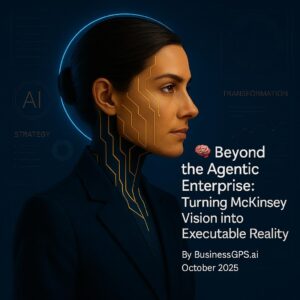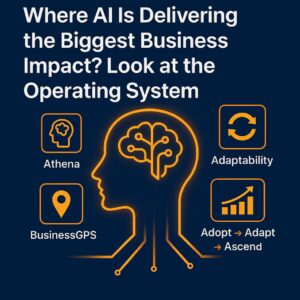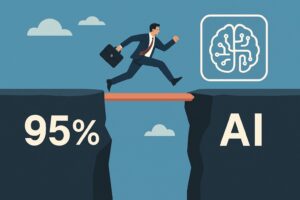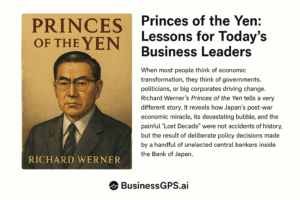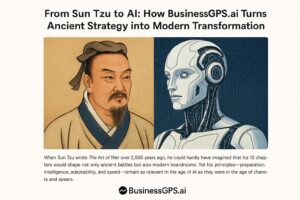
Your Five-Year Digital Transformation Plan Is Already Three Years Too Late
The AI inflection point has collapsed transformation timelines from years to months. Discover how forward-thinking SMBs are now implementing ‘ambidextrous transformation’ to outpace their competitors — without enterprise-level resources.

The Great Transformation Fallacy: Why Decades of “Innovation” Have Failed to Move the Needle
Having spent my career in the transformation trenches, I’ve witnessed a disturbing pattern: despite billions spent on methodologies, frameworks, and technologies, the majority of business transformations still fail. The hard truth? The transformation industry has been solving the wrong problem all along.
For thirty years, we’ve watched a parade of “innovations” march through boardrooms:
- Agile revolutionized software delivery
- DevOps bridged development and operations
- PMI Infinity modernized project management standards
- Digital tools like Jira promised perfect visibility into progress
Each promised to be the silver bullet. Each delivered incremental improvements at best. Why?
Because they all focused on optimizing delivery while ignoring the true constraint: the client organization itself.
The world’s best methodologies collapse when they meet organizations lacking the capacity, capabilities, or culture to absorb transformation. It’s like installing a Formula 1 engine in a family sedan without upgrading the transmission, suspension, or driver skills — impressive on paper, catastrophic in practice.
My earlier blog posts dissected these failure patterns, offering leadership teams strategies to navigate technology-led transformations with less friction. However, I was still working within the limitations of traditional approaches, applying better band-aids to a patient who needed surgery.
Then everything changed.
As a methods engineer by training, I’ve developed numerous frameworks over my career. But the breakthrough — the genuine paradigm shift — came with the advent of Generative AI. I was among the first to experiment with this technology, sharing early learnings here two years ago.
Now, as these models have evolved, we’ve reached a historic inflection point: for the first time, we have the means to fundamentally transform the transformation value chain itself.
The breakthrough innovation? Using GenAI to directly address and overcome client-side constraints — the very factors that have silently sabotaged transformation efforts for decades. Early results have been nothing short of revolutionary, showing improvements in speed, quality, adaptability, and success outcomes that previous approaches couldn’t touch.
This innovation couldn’t come at a more critical moment. As technologies like Generative AI and robotic automation reshape industries overnight, the complexity of successful adoption has increased exponentially. Yet the foundations and capabilities required for success remain elusive for most organizations — especially those without enterprise-level resources.
I’ve labeled this new approach “Ambidextrous Transformation” because it reflects the dual nature of what’s required: simultaneously optimizing today’s operations while building tomorrow’s capabilities. My forthcoming book will equip leadership teams with the mindset and know-how to develop the ambidextrous leadership capabilities that underpin successful transformations.
This post marks a turning point — introducing the first resources designed specifically to help you, the business leader, navigate a technology-centered transformation journey without falling into the traps that have claimed so many before you.
The question isn’t whether transformation is necessary — it’s whether you’ll attempt it with outdated tools or embrace the ambidextrous future that’s already here.
The Transformation Journey: Where We've Been
Remember when digital transformation meant installing a new ERP system and calling it a day? Those simpler days of the 1990s and early 2000s feel quaint now – like recalling the era of dial-up internet while scrolling through AI-generated content on your smartphone.
The first wave of digital transformation began with the ERP revolution. SAP, Oracle, and other enterprise software giants promised businesses the holy grail: a single system to rule them all. Organizations invested millions in these monolithic platforms, enduring multi-year implementations that tested even the most patient executive teams.
But reality fell short of the promise. While these systems delivered unprecedented data integration, they also created rigid process frameworks that struggled to adapt to changing business needs. The unforeseen consequence? A second wave emerged – the era of specialized systems.
From 2000 to 2015, we witnessed the proliferation of best-of-breed solutions – CRM platforms like Salesforce, supply chain systems, specialized HR tools, mobile applications, and web platforms. Each solved a specific business problem brilliantly but created a new challenge: fragmentation. The typical enterprise landscape became a tangled web of systems connected by brittle integrations and manual processes.
Meanwhile, digitally-native companies like Amazon, Google, and Facebook were writing a different story. Unencumbered by legacy systems, they built data-centric architectures from day one. When the big data revolution arrived in the 2010s, these companies - the Web 2.0 leaders - were the pioneers and structurally prepared to capitalize. At the same time, traditional enterprises scrambled to create data lakes and employ armies of data scientists to make sense of their fragmented information.
The cloud migration that followed didn't solve this fundamental problem – it merely relocated it. Organizations now had faster, more accessible systems, but the fragmentation remained. Most businesses managed dozens, if not hundreds, of applications across multiple cloud providers.
Then came the AI inflection point. When DeepMind's AlphaGo defeated world champion Lee Sedol in 2016, it signaled something profound: AI was no longer science fiction. The subsequent development of transformers and large language models has only accelerated this reality, opening up a world of possibilities.
The Transformation Journey: Where We Are
The AI Awakening of 2025 is a period marked by the widespread integration of AI capabilities into business operations. Today, in 2025, we stand at a transformation crossroads unlike any before it.
The enterprise software giants are scrambling to embed AI capabilities into their platforms. Look at SAP's new architecture – they've entirely reimagined their approach with transaction, data, and AI orchestration layers. Microsoft has integrated AI agents throughout its ecosystem. Every vendor is racing to claim their piece of the AI future.
But here's the uncomfortable truth: most businesses are stuck midstream. If you launched a digital transformation even two years ago – implementing cloud ERP, modernizing your CRM, or building a data warehouse – you're now watching the very foundations of that investment shift beneath your feet.
Consider this sobering reality: the typical enterprise transformation takes 3-5 years and costs millions. Yet the technological landscape has fundamentally changed in just the last 18 months. How confident are you that what you're implementing today won't be obsolete before it's finished?
Traditional consulting models are facing significant challenges. Major firms like IBM, Accenture, and the Big Four are grappling with an existential crisis as AI threatens to automate many roles within their workforce. These companies are quickly shifting towards data-driven and technology-augmented service models, understanding that the era of having large numbers of junior consultants conducting manual analyses is ending. This shift underscores the urgency for SMB leaders to adapt to AI-driven business transformation.
For SMB leaders, this creates a perfect storm of uncertainty:
- The technology landscape is shifting faster than traditional transformation approaches can adapt
- Legacy approaches require resources most SMBs don't have
- Picking the wrong path now could prove existentially costly
- Yet standing still is equally dangerous as competitors embrace AI capabilities
It's time to break free from rigid transformation methodologies. You need an approach that acknowledges the volatility of the current landscape and leverages your existing capabilities while exploring the potential of AI. It's time for a new, more adaptable approach to transformation.
You need ambidextrous transformation.
The Future State: Digital Transformation in 2030 and Beyond
Fast forward to 2030. The businesses that have thrived didn't just implement technology – they fundamentally reimagined how they operate in an AI-powered world.
The successful organization of 2030 bears little resemblance to its 2025 counterpart:
AI orchestration has replaced middle management. Routine decisions across the organization are handled by AI agents programmed with company objectives and values. These agents coordinate workflows, allocate resources, and optimize operations with minimal human intervention. Human managers focus on exception handling, relationship management, and strategic innovation – the human elements of business.
Continuous transformation has replaced project-based change. The notion of a "digital transformation project" with a distinct beginning and end is obsolete. Instead, organizations operate on continuous evolution cycles, with AI constantly identifying improvement opportunities and orchestrating their implementation. Change has become ambient rather than episodic.
Ecosystem integration has replaced application integration. Rather than connecting individual applications, businesses orchestrate capabilities through open ecosystems. The lines between your systems and your partners' have blurred, creating seamless value chains orchestrated by intelligent agents.
Decision intelligence has replaced data analytics. Instead of generating reports for humans to analyze, AI systems autonomously identify patterns, make predictions, and suggest – or even take – actions. Human judgment is reserved for novel situations and ethical considerations, not routine analysis.
Business models are perpetually fluid. The ability to rapidly reconfigure offerings based on market signals is the norm. Companies no longer think of fixed products and services but rather in terms of capabilities that augmented teams can dynamically recombine to meet emerging opportunities.
This future may sound like science fiction, but every technology required to achieve this future exists today in some form. The question isn't whether this transformation will happen but who will lead it and who will be left behind.
Bridging Today and Tomorrow: The Ambidextrous Approach
How do you navigate from today's reality to tomorrow's possibilities without betting your company on a single, expensive transformation that might miss the mark?
The answer lies in ambidextrous transformation – the ability to simultaneously optimize your current operations while building the capabilities that will define your future.
Traditional transformation approaches force a false choice: focus on quick wins or pursue long-term reinvention. The ambidextrous approach recognizes that you must do both simultaneously.
This requires a fundamentally different framework that treats transformation not as a one-time event but a continuous change capability. It demands tools that can orchestrate complex change without overwhelming your team. It increasingly requires AI assistance to manage the complexity that exceeds human cognitive capacity.
Consider how your transformation approach must evolve:
From project to product mindset: Instead of thinking about transformation as a series of projects with distinct endpoints, you must build continuous change capabilities that evolve with emerging technologies and market needs.
From monolithic implementation to modular architecture: Rather than committing to massive, all-or-nothing deployments, you need a modular approach to adapt components as technology evolves.
From human-led to AI-augmented orchestration: The complexity of modern business environments exceeds human cognitive capacity. AI orchestration is essential to manage dependencies, identify patterns, and coordinate activities across organizational boundaries.
From resource-intensive to capability-focused: Instead of brute-forcing transformation with expensive consultants and technology investments, focus on building the foundational capabilities that enable continuous adaptation.
Think of the difference between building a house and managing a city. Traditional transformation is like constructing a house – a discrete project with a clear beginning and end. Modern transformation is like urban planning – an ongoing coordination, adaptation, and evolution process that never truly ends.
Or consider another analogy: We've moved from a world where implementing systems was like launching individual airplanes (discrete projects) to one where we must build and manage entire airports – complex ecosystems where planes are constantly taking off and landing, capacity must be continuously optimized, and unexpected events require rapid adaptation.
How BusinessGPS.ai Enables the Ambidextrous Future
The challenges I've outlined require a new approach – one that wasn't possible until recently. The BusinessGPS.ai framework was explicitly built for this new reality, combining decades of transformation experience with the latest AI capabilities.
At its core, BusinessGPS.ai is built on two transformative elements:
- The O2O (Opportunity to Operations) Framework – A proven methodology for aligning strategic vision with operational execution, ensuring that transformation efforts deliver tangible value rather than theoretical improvements.
- AI-Orchestrated Implementation – AI agents that guide, coordinate, and accelerate transformation activities, dramatically reducing resource requirements while increasing success rates.
What makes this approach uniquely powerful for SMBs facing the 2025-2030 transition:
It addresses the "3 Cs" that constrain most SMB transformations:
- Cash: By using AI to accelerate and streamline transformation activities, costs are reduced by 40-60% compared to traditional approaches.
- Capacity: AI orchestration dramatically reduces the demands on your team, allowing them to focus on high-value activities while the system manages coordination and routine tasks.
- Capability: Built-in expertise and guidance reduce dependency on scarce specialized talent, making sophisticated transformation accessible to organizations without enterprise resources.
It enables true ambidexterity: Instead of forcing you to choose between optimizing today's operations and building tomorrow's capabilities, BusinessGPS.ai allows you to pursue both simultaneously through its unique phased approach.
It builds transformation as a continuous capability: Rather than treating change as a one-time event, the framework creates the foundations for ongoing evolution, ensuring your organization can adapt as technology and market conditions evolve.
Taking the First Step: From Theory to Action
The gap between recognizing the need for transformation and successfully executing it has never been wider. You may conceptually understand the AI revolution that's unfolding, but translating that understanding into practical action remains the critical challenge.
This challenge is precisely why we've created two resources to help you bridge this gap:
- The Ambidextrous Leadership Coach - Our free, AI ambidextrous leadership coach helps you understand the mindset of ambidextrous leadership and how to apply ambidextrous thinking to your situation.
- The Digital Transformation Success Maps – These free resources distill proven transformation patterns from hundreds of successful implementations, giving you a clear roadmap for navigating the complexities of modern transformation.
- Athena Executive – Our AI-powered transformation partner that generates customized Phase 0 preparation plans specifically for your business, identifying constraints and developing resource-efficient implementation pathways.
The businesses that will thrive in 2030 aren't waiting for the future to arrive – they're building it today. But they're doing so with approaches designed for the AI-enabled future, not methodologies anchored in the past.
The choice is yours: continue with transformation approaches designed for a world that no longer exists, or embrace the ambidextrous future with tools built specifically for the challenges and opportunities ahead.
Your transformation journey begins with a single step. Take it today.
[Download Our Digital Transformation Success Maps – Free]
[Get Your Customized Phase 0 Plan from Athena Executive]

